The briefs
To explore the principles of organic form, functionality, technical aesthetic, in designing a handle.
Learning evidence end result:
• you have understood and can apply a variety of 3D principles, and can exercise aesthetic judgement
• you have understood and can manage the design process
• You can plan and successfully meet the technical requirements of a project in both 2D and 3D
• Identify and successfully reconcile ergonomic and aesthetic requirements
What does even ‘organic shape’ mean
Organic shapes are free flowing shapes that can not easily be defined. As such, organic shapes are associated with things from the natural world, like plants and animals. Unlike Geometric shapes which have sides, or corners and usually have a name. For example, squares, triangle, rectangle, hexagon, circles etc are geometric because it has a clear edges one achieved. What organic shape is not is when it doesn’t contain a natural look and a flowing curving appearance. Most organic shape is by man made inspiration – this mean that it is NOT an exact “COPY” literally form of nature.
Here are some sample drawings between organic shape vs geometric shape.

Can you tell the differences? its HUGE!
Why is it so important to know shapes?
Many artist and designers look at the world in shapes. Every object can be broken down into simple shapes – either geometric or organic. This is technique very much useful to help artist drawing complex drawings and many other purposes. Did you know that organic and geometric shapes can also be use in a ways to communicate with the audience? YES, this have an impacted on how the design is being expressed and here is how:
When the design is attempting to create a piece that looks natural, flowing, calming or soft – organic shapes are generally the shapes of choice!
When the design is attempting to create a sense of chaos, rigidity, anger – then geometric shapes are used. Nonetheless, geometric shapes may also be used to create abstract interpretations of things that would normally be depicted as organic shapes.
Organic Form Inspiration
Man made creation
Have you heard of Ergonomics?
You have now ;))
- functional efficiency
- health and safety
- quality of working life
- ease of use
- comfort

- Hand grips should fit in the hands. Small hand grips are needed for smaller hand and larger grip for bigger hands.
- It should also allow enough space for the largest hand were possible.
- Accommodate both right- and left-handed.
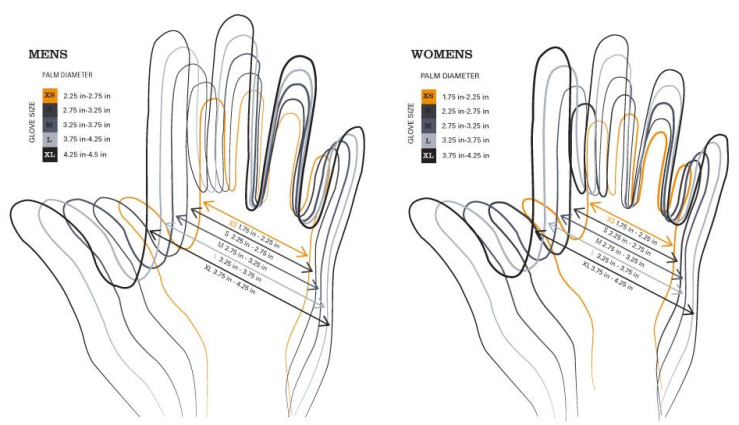
There are many different type of grip and depending on the objects, the dexterity of the hand is generally defined under two categories; power grips and precision grips.
Power grip/Cylindrical: Fingers and thumbs wrap around the object. (100% power, full contact with palm and fingers).
Precision grip/pinch: Forefingers and thumb hold the object (25% of potential power).
Precision unlike power grips are used with the intention of increased control as opposed to increased strength.

“When simple things need pictures, labels, or
instructions, the design has failed.”
Donald A. Norman (2000,p.9)
You have been chosen
 One of the main reasons why I have chosen honing steel to re-do the handle is because, as we all know – around this time of the year (13th May) is mother’s day!
One of the main reasons why I have chosen honing steel to re-do the handle is because, as we all know – around this time of the year (13th May) is mother’s day!
when it comes to think of a mother, they sure make delicious food! Every chef, or mother in the kitchen all use knives in their everyday life. Over time, of cause knives will become duller. Trust me when I say this, some people LOVE their favorite pair of knives! Therefore, honing steel is their best buddies to help maintaining knives. This is why I am interested in turning this stick into something special for mother’s day gift! (Although I have absolute no clue on how people use it before I choose this object).
Also, materials we will be using to create the handle is MDF or clear Pine then spray it with Matt white.This mean that this assignment project will likely not be water resistant. To clean the honing still, all u need is simply a rubber – this will avoid having to wash the tool and got the handle wet – which I thought it was awesome that I manage to find kitchen tool to avoid water (:
Okay, I will explain what honing steel is for – just in case.
Have you heard of honing steel before or seen one? You’ve probably (might have) seen a butcher use one before, if not in a real life at least in movies. If you do – do you also noticed that people use it many different ways too? I shall remind you with some screenshots I took from videos of professional chefs!
* Be sure to click on images to enlarge the pictures to see how they hold it differently *
But do you actually know what it suppose to do? no, impressing guests is not one of it.
Honing steel traditionally refers to a metal rod that you can stroke your kitchen knives with to bring back their sharpness. Normally, it is about the length of your forearm. To give this a conclusion: Honing is a maintenance task that should be performed quite often (once knife become duller) for example:

(Photo above: an electron microscope photograph [600x] of a stainless steel blade sharpened at 220 grit.)
As we can see, what is needed for those sections on the blade that have been temporarily folded over the amount of usage is honing Steel. This will pushes these problem areas back into place.
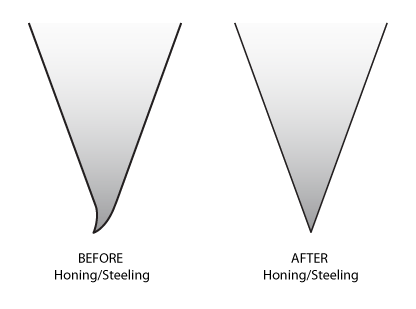
Here are the steps of using a honing steel the most common way:
1). Hold the steel vertically firmly in your hand.
2). Hold the knife firmly by the handle.
3). The tip of the blade should point upward.
4). Move the blade from the bolster (or back wide part of knife) to the point.
5). Hold the knife at an angle of about 20 degrees with a slight pressure over the steel.
6). Move the arm but not the wrist. Hold the steel at arms length in front of you.
7). The sharpening is done perfectly after 10 – 20 strokes of the knife over the steel.
My experience with honing steel for the first time, learn by following the steps and this is what it looks like:

Honestly, this feel very awkward! Maybe I’m not doing it right, or could it be that I was sitting and my arm was not feeling comfortable (this is not a good sign). Anyways, here are some thoughts and experience I have gained from doing this practice:
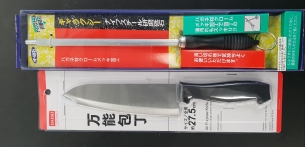
- Handle was too slim and thin which was very uncomfortable to hold with power grip.
- I have to use a some force to hold on the grip (not firm), otherwise it will not be stabilize.
- Length of the steel was too short, make it very uncomfortable to try different ways of holding this.
- The handle is so slim and thin on the head, which sort of lead me into trying to hold it in a pinch way but then it would slip out of my finger after certain about of force being press on the steel (image explanation below).
- hold the steel with the left hand and knife on the right hand feels a lot easier to have control on the knife.
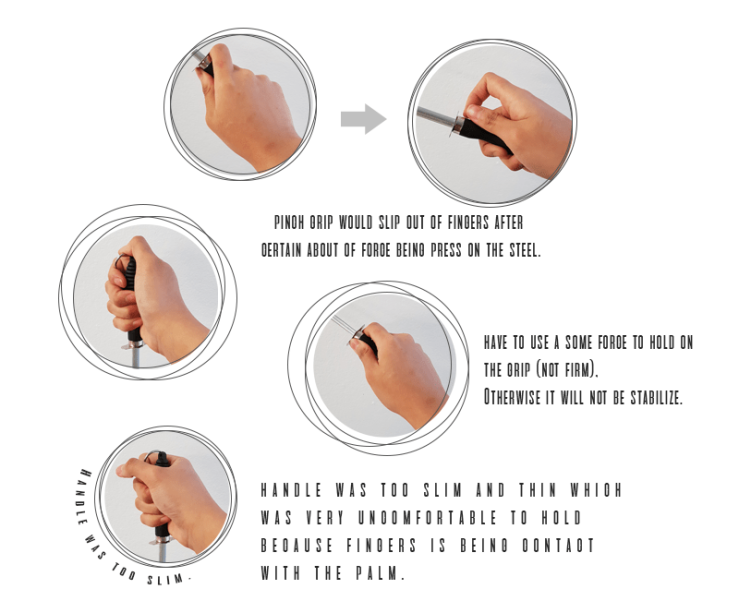
I can diffidently make an improvement on this handle.
I also have learn additionally that if you try to cheap out on the product, you are most likely not getting a decent quality. (Picture is shown the two product I have bought from Japanese store for $ 3.50 each).
Dern it, so I went to bought another steel which is a good quality that use ceramic type of material – It was $39 dollars! oh boy, I better not mess up on this assignment.
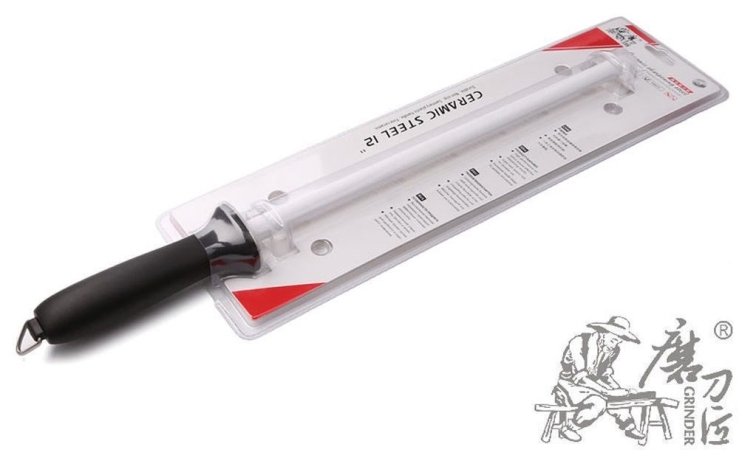
Problem is
I have done a lot of research on how to use it a proper way. Apparently there is no right and wrong way of holding the handle, there are just many ways that some people would prefer to use it and feel comfortable with. In my opinion, the original typical design of the handle has been honed to near perfection in role of the function perspective for every users – what else is there to improve on? Well actually on another thought, it’d be awesome if I managed to pull this off with elegant design that is organic shape and very much comfortable to use. SOMETHING DIFFERENT, something that most honing steel is lack of… and so the challenge began.
Solution:
- Positive thoughts
- Perhaps make a grip that leads people to hold it in a certain way?
- Learn how it is being held by different people. There are many ways and the angle is being held by the honing steel (which means the design i have to make would needed to fit in every angle perspective) here are some experience images shot I took:
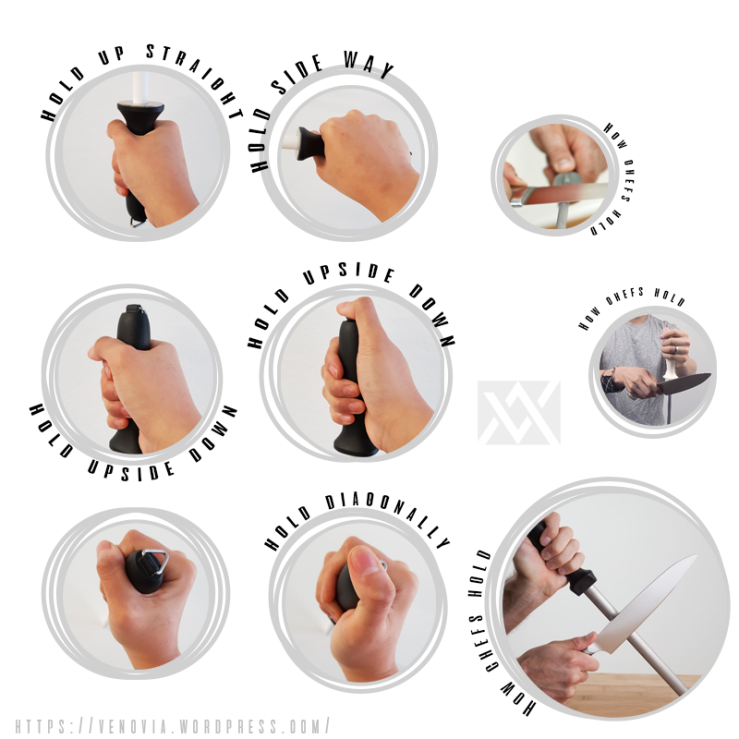
Its Biological, really
Hand is a complex organ and injuries to the hand and wrist are common. Certain injuries, if not treated promptly, may lead to serious complications which is why it is important for any industrial designers to understand how our hand works in order to design a handle which is will met the requirements of ergonomics.
Now that I know what my object is going to be, which is honing steel. I figure that the best handle grip to use would be Power grip!
Basic Power Grip Explanation
The Power grip (or Cylindrical grip) is an important movement that is performed daily when grasping a heavy cylindrical object. It generates the maximum gripping force possibly by hand and can be use with anything that has a handle like a hammer or honing steel for example.
When power grip is used, our first finger (thumb) is indicated by the flexion of 4 other digits fingers (index finger, middle finger, ring finger & pinky) and flexion and adduction (to draw inward toward)of the thumb around the object but in opposite directions. Another way to put it is, say if our digits 2-5 wrap around the object anti-clockwise then the 1st digit (which is the thumb) will wrap clockwise.
There are two groups of muscles of hand – Extrinsic muscles and intrinsic muscles.
Extrinsic muscles responsible for crude movements of hand whereas intrinsic muscles control fine movements. Unlike intrinsic muscles which are located within the hand itself. Extrinsic muscles originate approximately in the forearm and insert into the hand by long tendons.
Hand movement is add to strengthened and complemented by our wrist movements. Wrist muscles originate travel along extrinsic muscles of the hand and are considered together.
Power grip: Extrinsic hand Muscles
Major movers when using power grip is the extrinsic muscles which play a main role in the movement providing the major force. There are three extrinsic hand muscles that provide the vast majority of power generated in the power grip.
As we can see on the anterior view picture, those are all Flexors compartment of the forearm and are Flexor Digitorum Profundus, Flexor Digitorum Superficialis and Flexor Pollicis Longus.
Flexor Digitorum Profundus (FDP)
 FDP powerfully draws our finger digit 2-5 against the object being grasped pressing it against the palm of the hand. It also provides the greatest portion of tension and power to the grip because flexion of the distal interphalangeal joints around the object
FDP powerfully draws our finger digit 2-5 against the object being grasped pressing it against the palm of the hand. It also provides the greatest portion of tension and power to the grip because flexion of the distal interphalangeal joints around the object
Flexor Pollicis Longus (FPL)
FPL muscles allows the thumb to wrap around the object, creating a closed and much tighter grip because it is attaches to the distal phalanx (bone) of our thumb (1st digit). This work similar to FDP on finger digits 2-5 albeit on a different plane.
Flexor Digitorum Superficialis (FDS)
FDS muscle is an assists for FDP to provide greater tension in the flexed position. It has its distal attachment on the shaft of the middle phalanx of fingers digit 2-5 and flexes the proximal interphalangeal joints of those digits.
Moving on to minor movers: Intrinsic Hand Muscles

There are a some intrinsic hand muscles involved as an assist in the positioning of the fingers digits through action on the metacarpophalangeal (MCP) and some carpometacarpal(CMC) joints. This means that the positioning adopted will gives the optimal power to the grip.
Lets break down the explanation in much easier way to understand.
First of all, the thumb is adducted at both the MCP and CMC joints. Then, the 4th Dorsal Interossei brings the metacarpophalangeal joints of the finger digit 4 to a state of maximum lateral rotation and abductor digit minimi do the same for finger digit 5. Reason being is because these muscles can only be contribute to contribute the rotation when fingers are partially flexed. This shows us that fingers do laterally rotated and incline towards the ulnar side of the hand, not just do the flex to the size of the object held and press the object against the palm of the hand.
Shout out to Biodigital cheers, for awesome free education!
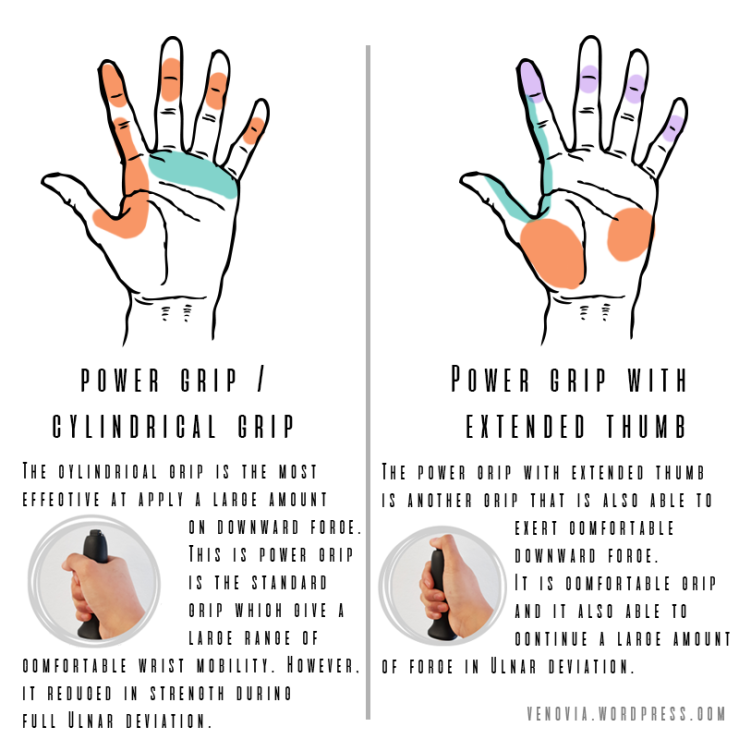
According to Bodysapce: Ergonomic and the design of Work
The average palm breadth (metacarpal) is 87mm. Therefore, a handle should be more than the palm which is no less than 95 mm. This is because if it is too long it will be visually unappealing, heavy, uncomfortable and difficult to find a storage space. If a handle is too short, it will be very uncomfortable to use and difficult to get a good power grip.
3D clay stick
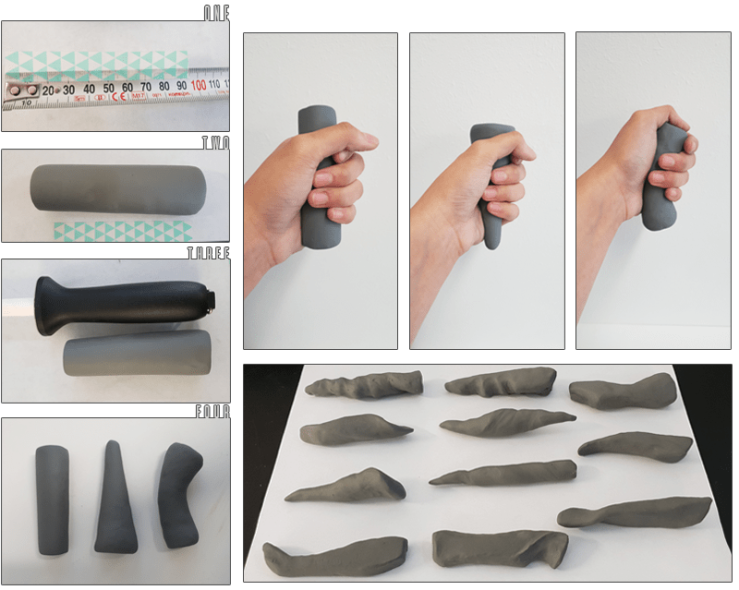



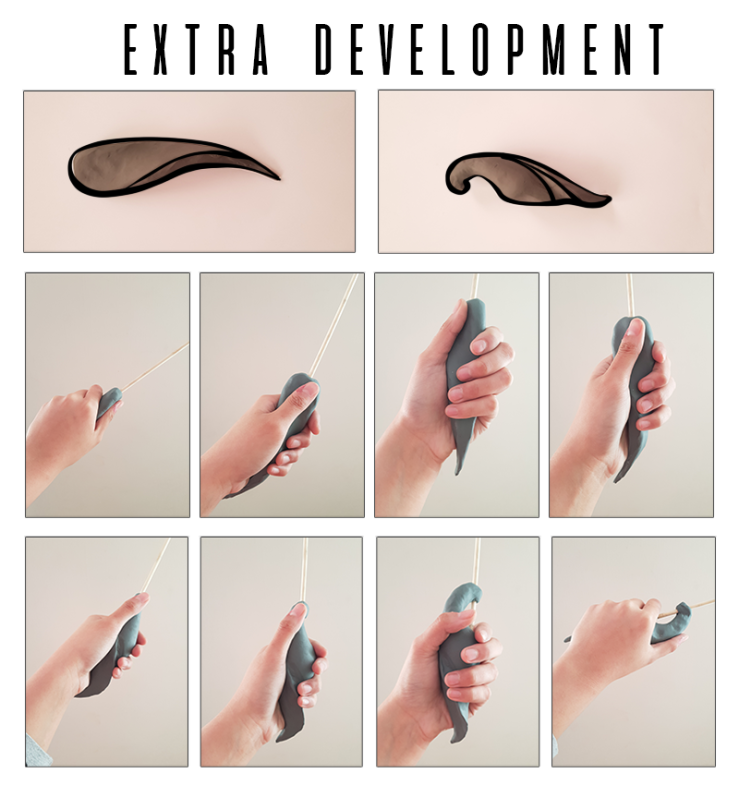
Fabulous Foam
Here I have develop 12 foam model in total, selected 1 and then develop 8 out of 1 shape.




































